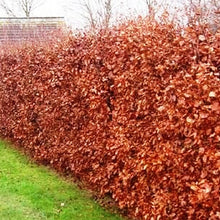AVAILABLE AGAIN MID OCTOBER.
Green beech makes an ideal gardenhedge. It is low-maintenance and is moderately fast growing (1-2ft per year) The leaves turn to brown/golden colour in Autumn/Winter, and it will still retain a large percentage of the foliage on the plant, until new growth comes in the Spring and pushes off the older leaves.
Leaves turns darker in colour as the plant matures. Beech hedges prefer a moist nutrient rich soil but will do well in most soil types. Beech can be easily pruned. Pruning will encourage the hedge to become thicker and fuller, providing a more dense coverage. It is similar in appearance to Hornbeam hedging. An attractive addition of native trees mixed in through the hedge enhances the overall hedge.
Bare-root Beech hedging plants are typically sown as bare-root plants in the Winter months from November through to April. Plants of 2-3ft are the most popular size for planting as the root systems are well developed and the plants are an ideal size for planting.
Pruning and trimming is usually done in the Spring, before birds begin to build their nests. In the first few years, it is best to prune the sides of the hedge and then once the desired height has been reached, you can then start pruning the top of the hedge to give that formal structure.
How & When to Plant Your Hedging Plants
Beech hedge plants are usually planted as bare root plants, at a frequency of 3 plants per metre roughly 1 foot apart and planted in a single row.
Beech plants can be planted in staggered double row with 5 plants per metre. Planting 5 plants per metre will give a thicker hedge over time.
Keep clear of long grass and weeds in the first few months to promote growth and a thicker, fuller hedge.
Beech hedging plants should be watered if planted in late Spring and there is a period of drought in the proceeding months.
When planting It is best to dig a trench 8-9 inches deep, breaking up and aerating the soil.
Place the plants in the trench, covering the root system up to the collar of the plant. Push back in the soil and firm the plant in to anchor it in the ground.




